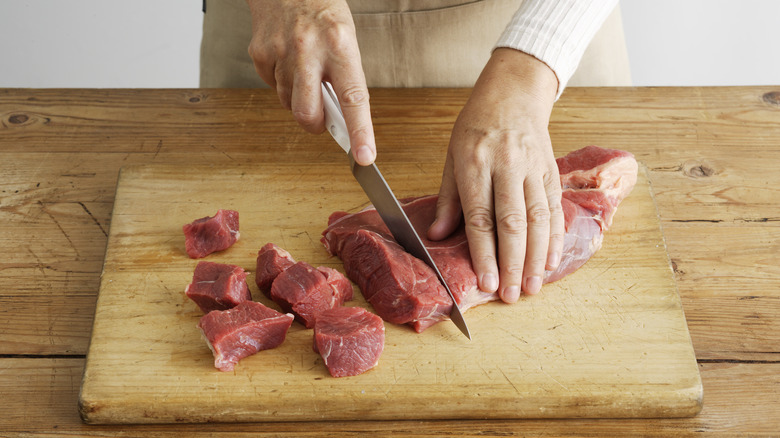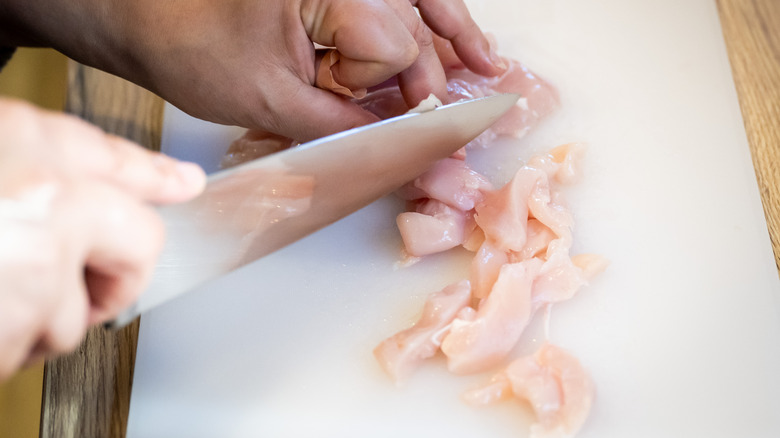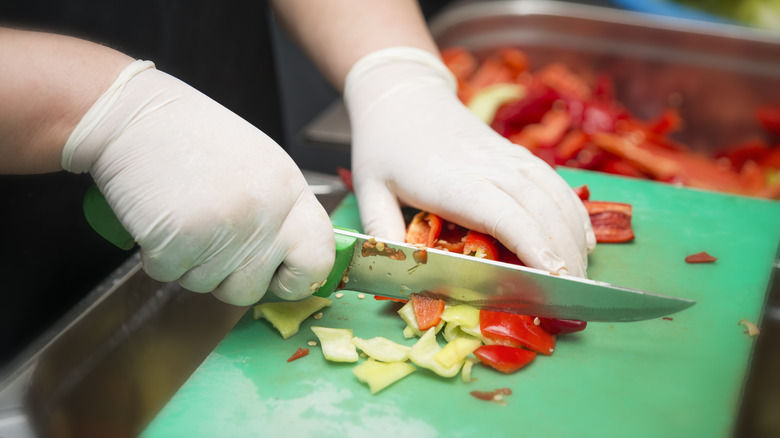The Cutting Board Mistake That Causes Huge Food Safety Hazards
You probably already know the basics of cleaning your cutting board — no matter what you're slicing, dicing, or chopping up on top of it, it usually leaves behind some residue that needs to be washed off. However, if you're slicing or handling any kind of raw meat on a cutting board and not washing it immediately after, you're putting your health at risk. You should never put food on a cutting board that's just had raw meat on it.
Raw beef, poultry, and even fish can leave germs on your cutting board once you're done with them. This includes all the usual suspects you see in warnings about eating raw meat: salmonella, E. coli, listeria, and plenty more. If you remove the raw meat and immediately start chopping veggies (for example) on the cutting board, then those germs can easily end up contaminating your food. At the bare minimum, the USDA says you should wash and sanitize your cutting board thoroughly after you handle raw meat on it. Of course, using a separate cutting board for raw meat eliminates the risk entirely.
Cleaning raw meat off your cutting board
Raw meat needs to be kept separate from other foods you eat, and many mistakes made with raw chicken or beef involve cross-contaminating your other foods by storing them too close or handling them with the same utensils. The only surefire way to kill bacteria on meat is to cook it — washing the meat before placing it on a cutting board does not make it safe. If you wash anything, it's much safer to rinse the cutting board directly after you're finished with the meat.
To sanitize a cutting board right after handling raw meat, you can rinse it with soap and hot water, and disinfect it using a cleaner like bleach or hydrogen peroxide (and then rinse it again in hot water). There's some debate over whether wood or plastic cutting boards are more sanitary; both should be alright, but wooden boards need to be cleaned more thoroughly while plastic boards can go in the dishwasher if they're thick enough. Some cutting boards have "juice canals" running around the edges, which can collect the liquids from raw meat, making them easier to clean.
Different cutting boards for different foods
Instead of worrying about whether your sanitizing job was thorough enough, you can also just get another board if you've got the space in your kitchen. It's common for restaurants to have multiple, different-colored cutting boards in their kitchen to avoid food contamination: Professional kitchens will typically use a red cutting board for raw meat, green for fruits and veggies, white for dairy, etc. Often, they'll separate the meats even further with distinct colors for poultry and fish.
This doesn't mean you need half a dozen different boards — restaurants do this because there are so many people working with the same equipment that it's difficult to keep track of when a cutting board was last used. However, keeping a "raw meat" cutting board and a "veggies and everything else" cutting board at home can help, with different appearances so you never mix them up. It's more convenient than always saving the meat for last if you're just working with a single board, and there's less danger of cross-contamination this way (just keep the two boards separated).


